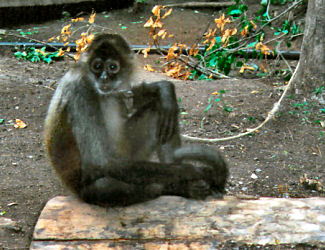|
| Query: spider | Result: 40th of 1418 | |
Geoffroy's Spider Monkey (Ateles geoffroyi) - Wiki
| Subject: | Geoffroy's Spider Monkey (Ateles geoffroyi) - Wiki
| |

| Resolution: 325x250
File Size: 42167 Bytes
Date: 2005:04:03 17:33:34
Camera: HP psc1300 (HP)
Upload Date: 2006:12:21 14:57:35
|
Geoffroy's Spider Monkey
From Wikipedia, the free encyclopedia
[Photo] Black-handed Spider Monkey (Ateles geoffroyi). Photographed in Costa Rica by Lea Maimone.
Geoffroy's Spider Monkey, Ateles geoffroyi, also known as Black-handed Spider Monkey, is a species of spider monkey, a type of New World monkey, from Central America.
http://en.wikipedia.org/wiki/Geoffroy's_Spider_Monkey
| The text in this page is based on the copyrighted Wikipedia article shown in above URL. It is used under the GNU Free Documentation License. You may redistribute it, verbatim or modified, providing that you comply with the terms of the GFDL. |
|
Comments |
|---|
| | Guest |
|
Black-handed Spider Monkey
Ateles geoffroyi
Ranges from Mexico to Colombia mostly in large areas of primary forest.
Arms are 25% longer than the legs opposite of most mammals.
Feeds only on fruits and leaves.
Has the strongest and most flexible prehensile tail of any mammal in the world.
Is listed as an endangered species and is protected by international law. |
| | Guest |
|
Geoffroy's spider monkey / Black-handed Spider Monkey
Ateles geoffroyi
SUBFAMILY
Atelinae
TAXONOMY
Ateles geoffroyi Kuhl, 1820, Nicaragua.
OTHER COMMON NAMES
English: Black-handed spider monkey.
PHYSICAL CHARACTERISTICS
Body coat varies in color from yellow, to red, to black, with black hands and feet. Cheek hairs stand out, and that hair on the top of the head forms a cowl that ends in a triangular crest over the brows.
DISTRIBUTION
Northeast and west coast of Mexico to Panama.
HABITAT
Evergreen rainforest, semi-deciduous forest, mangrove forest.
BEHAVIOR
Multimale, multifemales groups with over 40 individuals routinely split up into smaller foraging parties and are rarely observed together. Males remain in their natal groups, and tend to associate more with one another than with females. Males have hierarchical relationships, but also affiliate more closely with one another than with females. At Barro Colorado Island, Panama, males were observed to engage in fur-rubbing behavior more commonly than females.
FEEDING ECOLOGY AND DIET
Geoffroy's spider monkeys at Santa Rosa National Park, Costa Rica prefer fruit, which comprises over 70% of their annual diet. Chapman found that they adjust the size of their feeding parties to the size of fruit patches. Day ranges average about 4,265 ft (1,300 m), within a home range of 420 acres (170 ha). They may be important seed dispersers of the fruit species they eat.
REPRODUCTIVE BIOLOGY
Ovarian cycles last from 20 to 23 days in length. Birth intervals are about three years, and may be concentrated in more seasonal habitats.
CONSERVATION STATUS
Not listed by the IUCN.
SIGNIFICANCE TO HUMANS
Hunted for meat. |
| | tahler |
|
| spidermonkeys are so cute |
^o^
Animal Pictures Archive for smart phones
^o^
|
|
|

